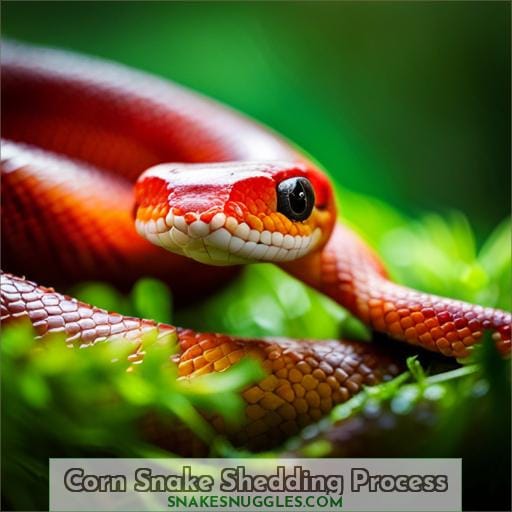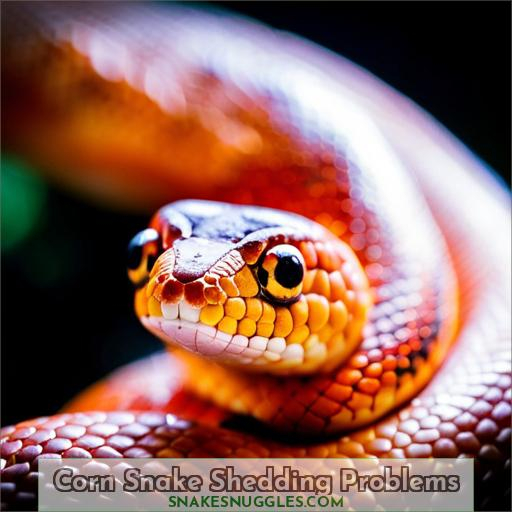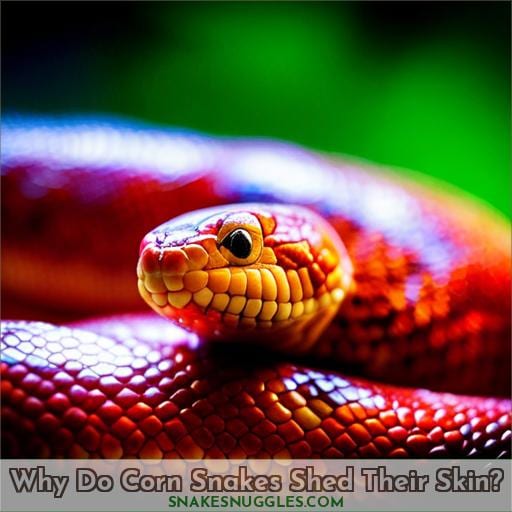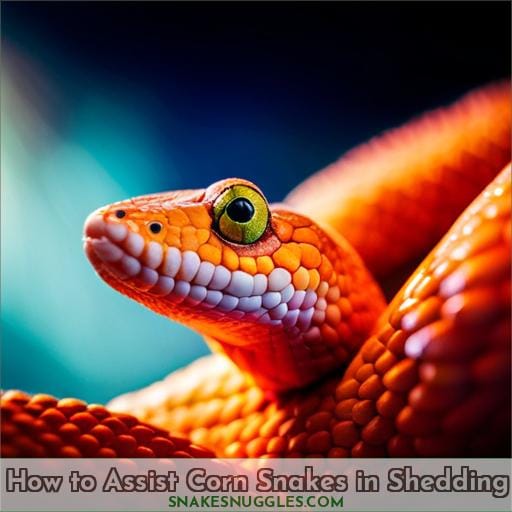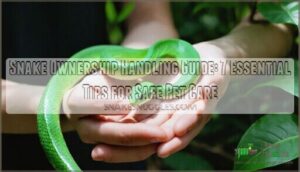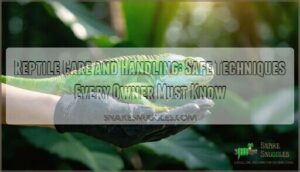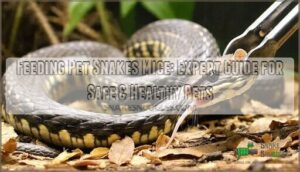This site is supported by our readers. We may earn a commission, at no cost to you, if you purchase through links.
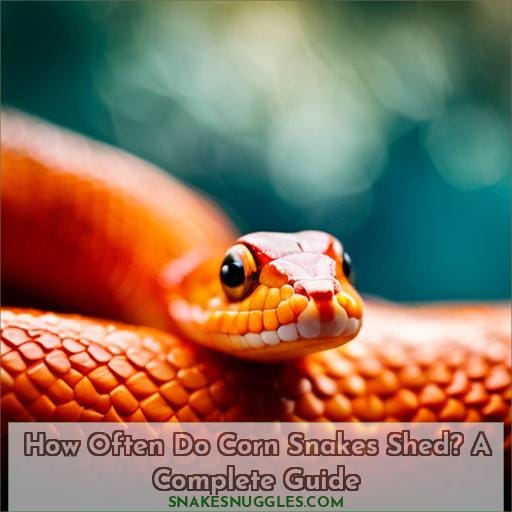 Coincidentally, you may have noticed your corn snake’s eyes turning a cloudy, bluish-white color – the first sign of an impending shed. Shedding is an essential part of life for any reptile and occurs because their bodies are growing faster than their skin can keep up with.
Coincidentally, you may have noticed your corn snake’s eyes turning a cloudy, bluish-white color – the first sign of an impending shed. Shedding is an essential part of life for any reptile and occurs because their bodies are growing faster than their skin can keep up with.
But how often do corn snakes shed? Hatchlings typically start shedding every 4-6 weeks and adults only about 4 to 5 times each year in line with seasons or breeding times.
Table Of Contents
- Key Takeaways
- Corn Snake Shedding Process
- Corn Snake Shedding Problems
- Why Do Corn Snakes Shed Their Skin?
- How to Assist Corn Snakes in Shedding
- Frequently Asked Questions (FAQs)
- What is the optimal temperature and humidity for successful corn snake shedding?
- Can corn snake shedding be accelerated?
- What is the difference between juvenile and adult corn snake shedding?
- How can I tell if my corn snake is about to shed?
- Are there any nutritional requirements for corn snakes during shedding?
- Conclusion
Key Takeaways
- Hatchlings shed every 4-6 weeks; adults shed 4-5 times yearly based on seasons.
- Blue phase: characterized by cloudy eyes, dull scales, occurs 3-4 days before shedding.
- Maintain humidity at 30-50%, avoiding levels exceeding 50%.
- Shedding duration: 4-7 days; monitor behavior and signs closely.
Corn Snake Shedding Process
Are you curious about corn snake shedding? Shedding is an essential part of the life cycle for these reptiles. Learn more about when snakes typically shed their skin, what the blue phase looks like, how they go through this process, and how long it takes to complete.
What Time of Year Do Snakes Shed Their Skin?
You may notice that your snake’s shedding frequency increases in the warmer months, as wild corn snakes tend to shed more during this time.
The blue phase is a period of 3-4 days before shedding when their eyes become cloudy or milky. This can be followed by an increase in hiding, lethargy, and loss of appetite as they approach the final stage of the process.
To help with successful seasonal shedding, provide proper humidity levels and a moist hide for them to complete their skin renewal cycle without difficulty or complications from retained eye caps. Ensure there are no dry spots on its body and keep hydration levels up by providing occasional warm baths if needed.
Corn Snake Blue Phase Description
The blue phase is the pre-shedding stage for corn snakes. During this stage, their eyes may appear cloudy or milky, and dull scales are visible. Snakes become more active, rub against objects, and seek out higher humidity levels.
This period lasts 3-4 days before they enter shedding mode. Proper care with reptile baths and controlled humidity/temperature can make a difference in skin shedding success. Assistance may be needed if retained eye caps develop or tail tips remain stuck.
How Does a Corn Snake Shed?
Experiencing a shedding cycle is an essential part of being a reptile, and corn snakes are no exception. Shedding frequency varies according to size, with hatchlings usually shedding every 7 days and adults slipping off their skin every 4-8 weeks on average.
Signs that indicate the start of this process include cloudy eyes, dull scales, increased activity, or hiding behavior – all symptoms which increase in severity during the blue phase. To ensure successful shedding periods, it’s important to maintain consistent moisture levels and temperature control.
A moist hide or soaking in warm water can help complete the shed if complications arise, such as retained eye caps or tail tips.
How Long Does It Take for a Snake to Shed Its Skin?
Shedding typically takes 4 to 7 days, so it’s important to monitor your snake’s behavior during this time. Signs of shedding include cloudy/milky eyes and dull scales. Prepare for the shed by maintaining moisture levels with a moist hide or increased humidity.
During the blue phase, which is a 3-4 day period prior to shedding, baby corn snakes may increase activity, rubbing, and seek higher humidity levels. On the other hand, adults may become more inactive and lose appetite. With proper care, such as steady temperature and humidity, you’ll likely avoid problems like tail tip retention or stuck shed.
If these issues do occur, warm water treatment or special bath solutions for reptiles like Zilla ShedEase Reptile Bath can help facilitate the successful shedding process.
This will restore a healthy growth rate in corn snakes between 4-8 weeks, depending on size, and help them heal from injuries faster.
Corn Snake Shedding Problems
Shedding is an essential process for corn snakes, but sometimes issues can arise. Shedding in pieces, shedding too often, and eye caps that won’t come off are common problems faced by owners of these reptiles.
In this article, we will discuss how to recognize and address such issues so your snake remains healthy during the shedding process.
Shedding in Pieces
If your reptile’s shedding process seems to be getting stuck in pieces, it could be a sign that something is amiss. Trapping humidity within the environment and providing proper shedding tips can help with skin regeneration.
Snake shedding behavior may vary based on the season, so it is important to increase humidity for successful sheds. You can assist in the shedding process by soaking your snake in warm water or using a Zilla ShedEase Reptile Bath solution.
This solution helps remove old skin more easily and safely from all body parts of reptiles such as snakes, geckos, and iguanas.
If you take these steps seriously, you should have no problem avoiding any potential issues with reptile skins during their shed cycle!
Shedding Too Often
You may be surprised to find that your corn snake is shedding too often. This could be a sign of inadequate moisture levels, stuck shed, or skin issues. To ensure your snake’s health and prevent retained eye caps or tail tip shedding, make sure the humidity levels are optimal for complete sheds.
If you notice dull scales and cloudy eyes during the blue phase preceding shedding, check pressure points such as its nose bridge regularly to help it remove any stuck shed pieces before they harden into place again.
With proper care, you can maintain healthy snakes with regular successful sheds!
Eye Caps Won’t Come Off
The blue phase of your reptile’s shedding may be a sign that their eye caps won’t come off easily, as if they’re stuck in place like glue. Proper hydration and humidity levels can help shed the skin more easily, although albino corn snakes may have difficulty with this process.
If sagging skin or loss of appetite persists after the blue phase, monitor closely for timid behavior and difficulties with shedding. To assist in removal, you can use warm water or a cotton swab, but take care not to cause any harm.
Why Do Corn Snakes Shed Their Skin?
Shedding helps keep your corn snake feeling and looking its best! Corn snakes shed their skin to accommodate growth, weight changes, injury healing, and reptile health.
Shedding usually takes 4-7 days. Signs such as cloudy/milky eyes or dull scales appear 3-4 days before the shed starts. Hatchlings can start shedding around 7 days old, while juveniles may shed more frequently due to rapid growth.
Proper humidity and hydration are essential for successful shedding. Make sure there is a moist hide available or increased humidity levels when necessary. Dry conditions can cause incomplete pieces of skin left on the snake’s body, leading to issues like retained eye caps.
Stressful situations like seasonal changes will affect the frequency of shedding. Wild corn snakes may have higher activity during warmer months, leading them to increase their shedding rate. However, this can be regulated by maintaining proper temperature and humidity levels in captivity at all times.
How to Assist Corn Snakes in Shedding
To help your corn snake in the shedding process, have you considered using a concentrated bath solution like Zilla ShedEase Reptile Bath? Proper hydration and humidification are essential for successful shedding.
It’s easy to use; just fill a shallow bath with the reptile’s head out of the water and soak it for 20 minutes. The warm temperature helps loosen old skin while also aiding healing from injuries or weight changes.
Furthermore, this solution can help remove stuck sheds on various body parts such as eye caps, tail tips, or albino snakes’ unfinished sheds that may be hard to detect without assistance.
- Increase humidity levels prior to shed periods.
- Monitor activity during the blue phase (3-4 days before actual shedding).
- Soak in warm water if needed.
- Remove stuck shed gently with warm water or a cotton swab promptly when necessary.
With these steps combined, you should be able to support your pet through their growth process safely and successfully!
Frequently Asked Questions (FAQs)
What is the optimal temperature and humidity for successful corn snake shedding?
Optimal temperature and humidity for successful corn snake shedding? Amazingly, the ideal environment is one with consistent levels of warmth and moisture. Maintain temperatures between 75-85 degrees Fahrenheit, paired with a relative humidity of 65-75 percent, to ensure proper shedding.
Can corn snake shedding be accelerated?
Yes, by providing the correct temperature and humidity levels in your reptile’s enclosure and bathing them with a ShedEase bath solution, you can help accelerate their shedding process.
What is the difference between juvenile and adult corn snake shedding?
Juvenile corn snakes tend to shed more frequently as they grow quickly, with an average of 4-8 weeks. Adults, however, can go for months between sheds due to their slower growth rate.
How can I tell if my corn snake is about to shed?
Look for signs such as cloudy eyes, dull scales, increased activity, and rubbing against surfaces. You may also notice a period of blue coloration before shedding begins. Your corn snake’s appetite might decrease too – an unmistakable sign that it is getting ready to shed its skin! Make sure the environment has proper humidity levels to aid this process and ensure your snake stays hydrated.
Are there any nutritional requirements for corn snakes during shedding?
Yes, during shedding, corn snakes require more nutrients to facilitate their growth. An addition of calcium and vitamin D3 supplements should be added to their diet for optimal nutrition.
Conclusion
It’s no secret that shedding is essential for corn snakes to stay healthy and grow. In order to ensure successful shedding, monitor behavior changes, maintain a steady temperature and humidity, and provide proper care.
If issues arise, such as retained eye caps, don’t hesitate to give a helping hand with warm water or a cotton swab.
While corn snakes shed more frequently in warmer months, the frequency can be reduced with proper humidity and temperature levels. To sum up, corn snakes shed their skin regularly to accommodate growth and healing.
By following these simple tips, you can easily ensure that your corn snake has a successful and safe shedding process.

